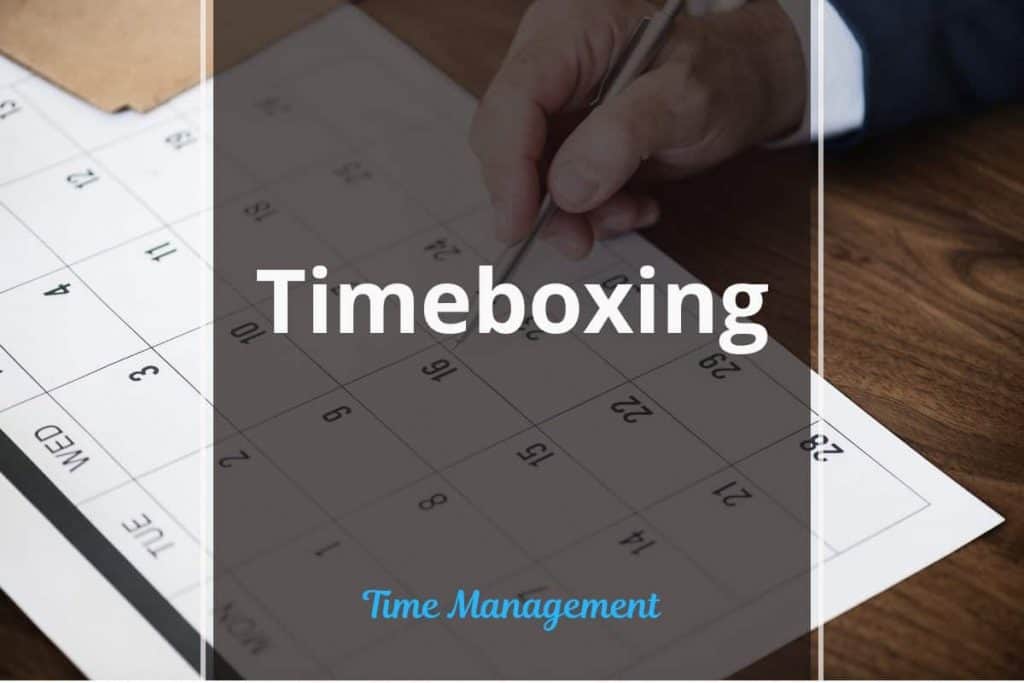🖊 This article was last updated on August 15, 2019
Obviously, working from home has many advantages, let’s be clear on that. However, a lot of entrepreneurs who have or are starting an online business are struggling with their time management and the never-ending to-do list that generate a huge source of frustration.

How many times did you race against the clock to finish your tasks and meet the deadlines?
Our to-do lists are never empty, they are a place where our tasks go to wither and die. In turn, this leaves us irritated, unproductive, and stressed. Many people that work from home struggle with overwhelm and too many things that need to be done in too little time.
Timeboxing can help you
Your time as an entrepreneur is often very limited, so timeboxing is important to make sure the right tasks get the right amount of your attention and focus. Timeboxing helps you to do tasks with both attention and intention.
This approach allows you to devote a pre-planned, fixed amount of time in your calendar for most important tasks. To put it simply, timeboxing is a great hack for scheduling your workday to get the most done.
How to use Timeboxing in your Time Management?
Timeboxing (sometimes also called time blocking) is a time management technique that represents a maximum, fixed time period planned for a certain activity. This time frame is called a time box.
This means that you will stop your work when the time limit for that task is reached, and evaluate what was achieved within the timebox.

the Timebox approach is used to address the tasks in a smaller time frame, thus offering the opportunity to work with time, instead of struggling against it. Organizing your work within the fixed timeframe can help you set the priorities, be more effective, and ease anxiety.
Depending on the work that needs to be done, the timeboxing time scales can range from a few minutes to several hours. The central rule here is that the work stops at the end of the designated timebox. After the time is up, you should always review your accomplishment.
Timeboxing Rules to Follow
Timeboxing is definitely one of the greatest hacks for increasing your productivity. This time management technique encourages you to concentrate on your time instead of your tasks. To organize your daily schedule with time blocking, you need to follow a few simple rules.
- Make your to-do list. Include all the relevant tasks and sort them by priority.
- Estimate how long each task/item on your to-do list should take to complete.
- Allocate a timebox – a certain number of minutes or hours to each task from your to-do list. Use this time only to complete that specific task.
- Plan breaks within your timebox. Remember that breaks are important as well. Taking a short break will help you relax and boost your energy.
- Set a timer to alert you when your timebox expires. Stick to a designated time frame per task. Once you review your accomplishment, you can move on to your next timebox.
Don’t stress yourself setting your timebox too short. Allow the length of time that works best for the work that needs to be completed.
Timeboxing Techniques
A common timeboxing technique is the Pomodoro, it involves working in short segments (usually of 25 minutes), followed by a short break. If you don’t finish the work within your timebox, you can continue it until you reach your goal. However, make sure to review your progress at the end of each timebox.
the Pomodoro technique will help you boost your productivity and feel more energized and motivated to reach your goals.
Timeboxing Benefits
Focusing on the time spent on a certain task, not only on concentrating on getting a task done has a number of advantages.
Firstly, the time limit forces you to ignore distractions. Therefore, deadlines may improve your focus and increase your creativity.
Secondly, time boxing narrows your focus to one activity or task at a time. Many people find that they lose time when multitasking. They have a hard time to focus and switch between the tasks effectively.
Time blocking allows you to prioritize the tasks on your to-do list and complete them one by one. Once you complete more important tasks, you move on to the smaller ones.
Furthermore, time boxing gives you the opportunity to measure your productivity levels. You can use a timebox to schedule the high-priority tasks during your peak productive time of the day. In addition, this time management method allows you to determine whether you have enough time for other projects, thus avoiding a risk of procrastination, stress, and burnout.
Finally, time blocking will help you feel less stressed and less anxious about your to-do lists and your working day. And the work you deliver will definitely be much better quality!
Awesome, isn’t it?

Nevertheless, to ensure the maximum use of this time management technique, you need to plan wisely. Make sure to set the appropriate length of time for your timeboxes, so they are not too short or too long. If they are too short, you may not accomplish much and therefore feel frustrated and anxious. On the other hand, if you set your timeboxes too long, you risk to lose your focus or delay finishing the work.
In addition, there are projects that need to be done to a high standard, no matter how long they take. In this case, time blocking may not be the most suitable time management method.
Therefore, keep in mind that timeboxing is a very helpful approach, but only if you use it when it is appropriate.
Extra Time Blocking Tips
Identify your priorities. Make a daily list of your top three priorities and get them done first (Hint: these are your important tasks). The main use of a timebox is to make progress on your most important tasks (MIT’s) – this enables you to constantly make progress towards your goals while ensuring that work on your important tasks doesn’t swarm over the rest of your day.
Make a list of your urgent tasks. Less important, but urgent, tasks also require organization and prioritization. Set up a timebox for each of smaller tasks as well and get them done accordingly.
Plan activities and tasks in your private life. Plan events and activities in your private life as well, and amount of time you’ll devote to each of them.
Use your most productive time wisely. Block time for the high-priority tasks in the most productive time of the day.
Plan your time blocks. Devote a small block of time at the end of your day to plan your timeboxes for the following day. Write down the to-do list of 3-5 high-priority tasks and any other tasks you have to get done. Then split your regular working day into the timeboxes, and dedicate each of them to a different task or a set of tasks.
Remember your goals. Keep in mind that your goal is not to stick with the time blocking schedule no matter what. If your circumstances throughout the day change, rework your timeboxes and adjust them to new conditions.
The key purpose of timeboxing is to make sure that you use your time effectively. By assigning a specific deadline to each task, time blocking allows you to analyze your progress at the end of each block and see what are you being unrealistic about and what you should be more focused on.

Organizing your to-do list in a specific time chunks can help increase your focus, motivation, and productivity. Finally, timeboxing can help you finish each working day satisfied and content rather than stressed and worn-out.
- These Black Friday deals will skyrocket your productivity (2021 edition) - November 11, 2021
- How to Stay Productive as a Digital Nomad - December 23, 2019
- When is the right time to outsource? - December 3, 2019

